Holmes Institute HI6006: Competitive Strategy Assignment Analysis
VerifiedAdded on 2022/12/28
|8
|1685
|21
Essay
AI Summary
This essay provides a comprehensive analysis of competitive strategy development tools, focusing on Porter's Generic Strategies, SWOT framework, Ansoff Matrix, and PESTEL analysis. The essay explores how these models can be applied to real-world business scenarios, using Apple Inc. as a case study. The student examines Apple's implementation of a broad differentiation strategy, its strengths, weaknesses, opportunities, and threats (SWOT), and how it utilizes the Ansoff Matrix for strategic growth. The PESTEL framework is also applied to assess the external factors influencing Apple's operations. The essay demonstrates a clear understanding of these strategic tools and their practical applications in a competitive business environment, supporting the student's ability to analyze and develop effective business strategies. The essay is well-structured, includes appropriate references, and adheres to the assignment guidelines, providing a valuable resource for students studying competitive strategy.
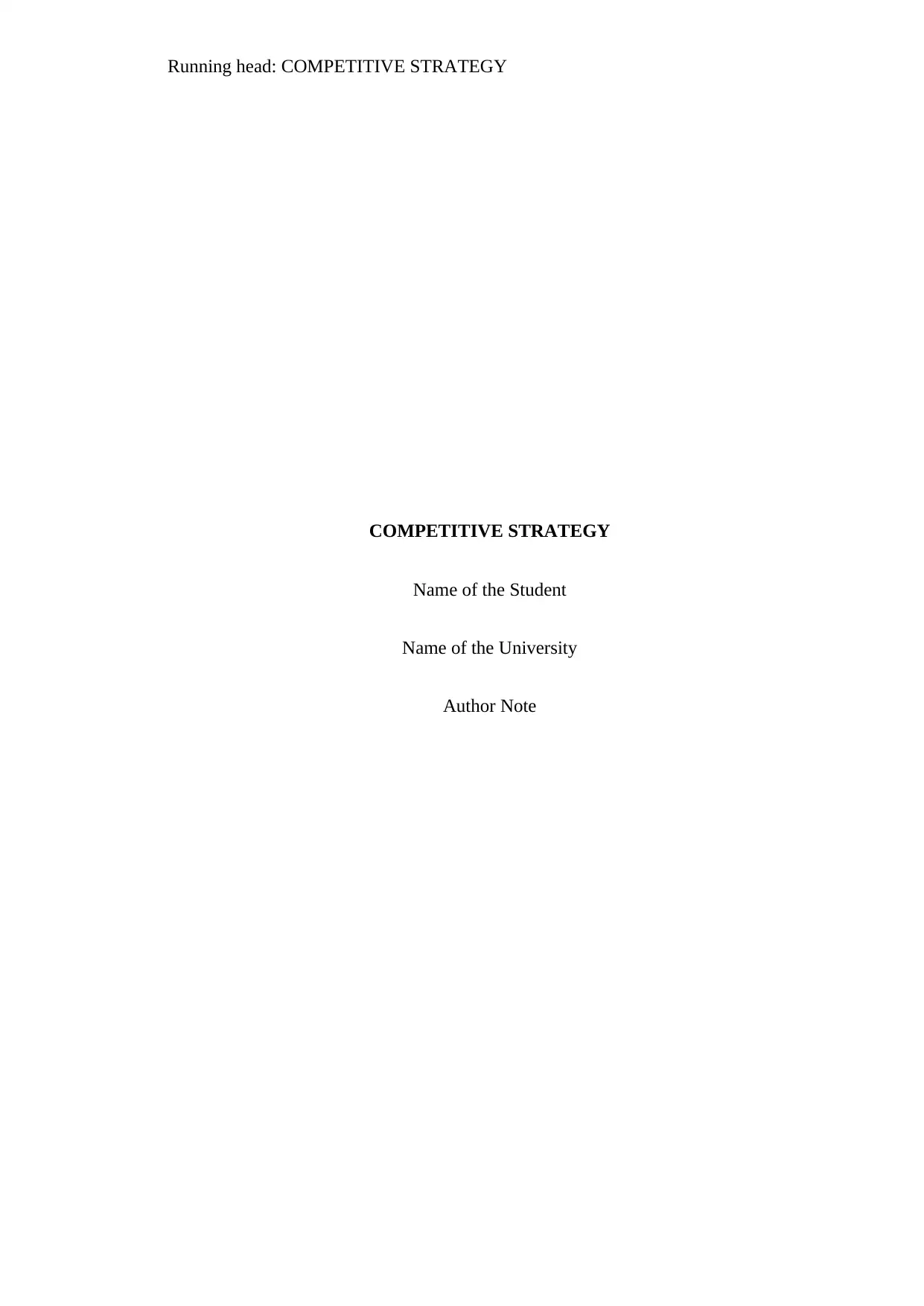
Running head: COMPETITIVE STRATEGY
COMPETITIVE STRATEGY
Name of the Student
Name of the University
Author Note
COMPETITIVE STRATEGY
Name of the Student
Name of the University
Author Note
Paraphrase This Document
Need a fresh take? Get an instant paraphrase of this document with our AI Paraphraser
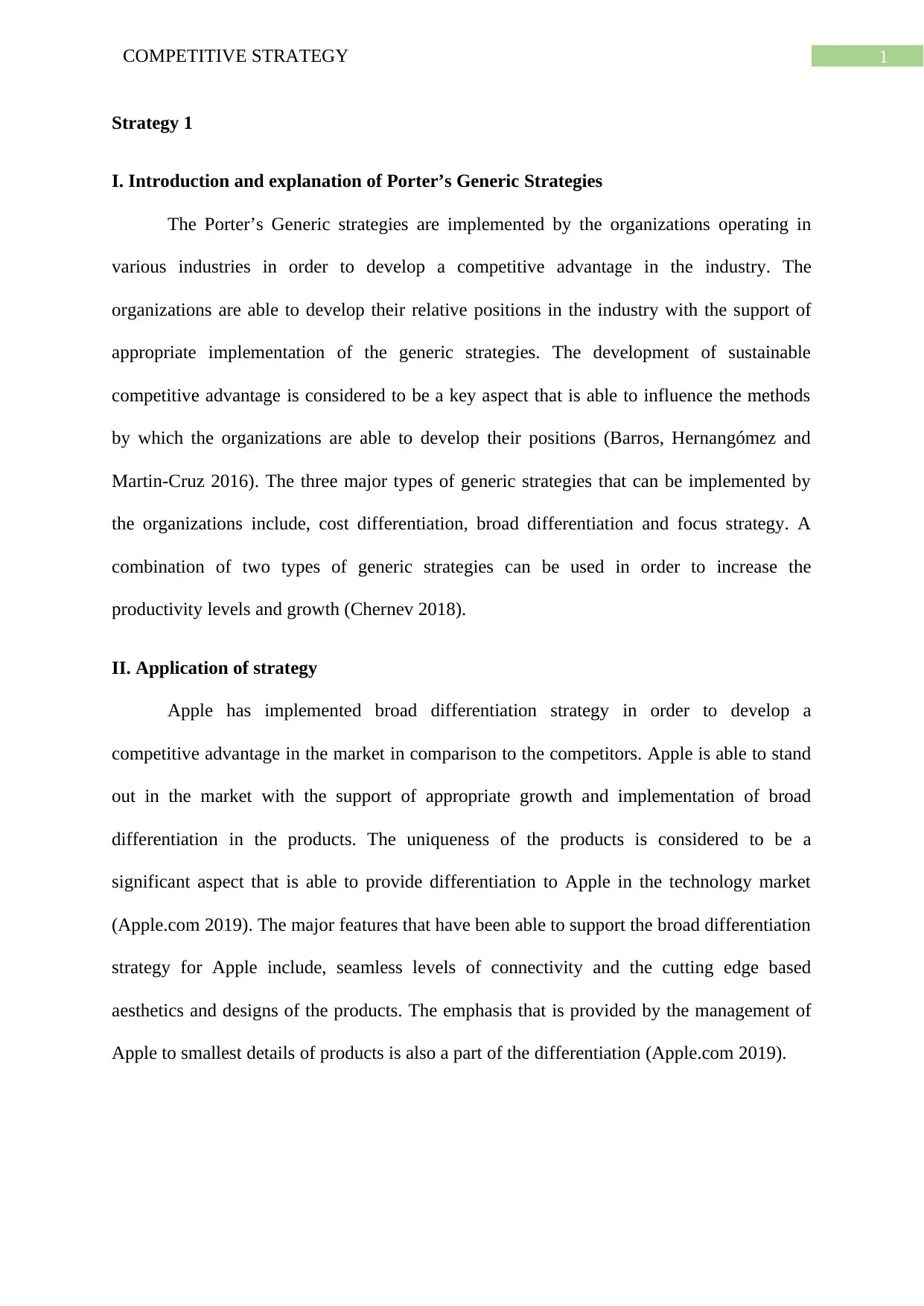
1COMPETITIVE STRATEGY
Strategy 1
I. Introduction and explanation of Porter’s Generic Strategies
The Porter’s Generic strategies are implemented by the organizations operating in
various industries in order to develop a competitive advantage in the industry. The
organizations are able to develop their relative positions in the industry with the support of
appropriate implementation of the generic strategies. The development of sustainable
competitive advantage is considered to be a key aspect that is able to influence the methods
by which the organizations are able to develop their positions (Barros, Hernangómez and
Martin-Cruz 2016). The three major types of generic strategies that can be implemented by
the organizations include, cost differentiation, broad differentiation and focus strategy. A
combination of two types of generic strategies can be used in order to increase the
productivity levels and growth (Chernev 2018).
II. Application of strategy
Apple has implemented broad differentiation strategy in order to develop a
competitive advantage in the market in comparison to the competitors. Apple is able to stand
out in the market with the support of appropriate growth and implementation of broad
differentiation in the products. The uniqueness of the products is considered to be a
significant aspect that is able to provide differentiation to Apple in the technology market
(Apple.com 2019). The major features that have been able to support the broad differentiation
strategy for Apple include, seamless levels of connectivity and the cutting edge based
aesthetics and designs of the products. The emphasis that is provided by the management of
Apple to smallest details of products is also a part of the differentiation (Apple.com 2019).
Strategy 1
I. Introduction and explanation of Porter’s Generic Strategies
The Porter’s Generic strategies are implemented by the organizations operating in
various industries in order to develop a competitive advantage in the industry. The
organizations are able to develop their relative positions in the industry with the support of
appropriate implementation of the generic strategies. The development of sustainable
competitive advantage is considered to be a key aspect that is able to influence the methods
by which the organizations are able to develop their positions (Barros, Hernangómez and
Martin-Cruz 2016). The three major types of generic strategies that can be implemented by
the organizations include, cost differentiation, broad differentiation and focus strategy. A
combination of two types of generic strategies can be used in order to increase the
productivity levels and growth (Chernev 2018).
II. Application of strategy
Apple has implemented broad differentiation strategy in order to develop a
competitive advantage in the market in comparison to the competitors. Apple is able to stand
out in the market with the support of appropriate growth and implementation of broad
differentiation in the products. The uniqueness of the products is considered to be a
significant aspect that is able to provide differentiation to Apple in the technology market
(Apple.com 2019). The major features that have been able to support the broad differentiation
strategy for Apple include, seamless levels of connectivity and the cutting edge based
aesthetics and designs of the products. The emphasis that is provided by the management of
Apple to smallest details of products is also a part of the differentiation (Apple.com 2019).
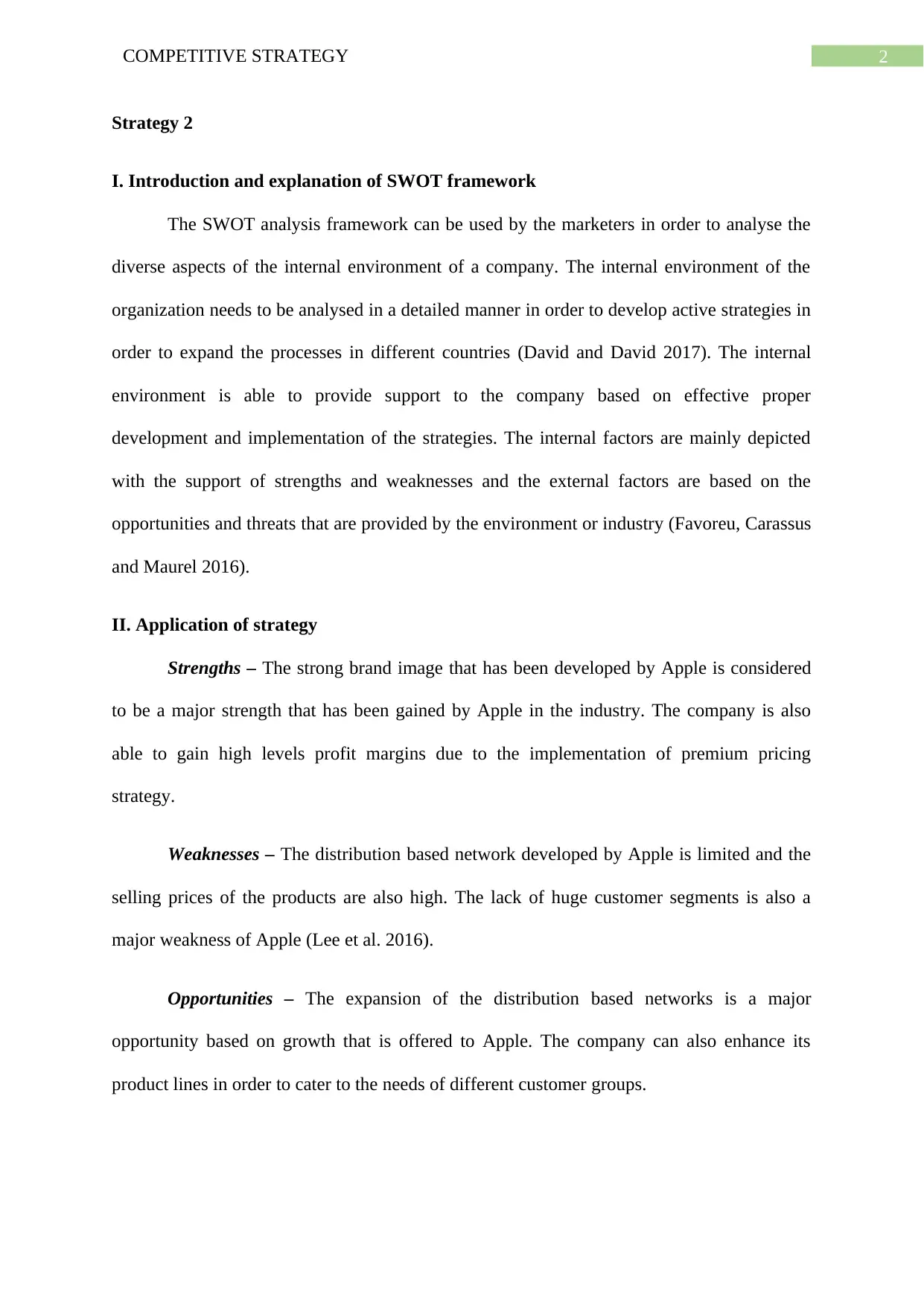
2COMPETITIVE STRATEGY
Strategy 2
I. Introduction and explanation of SWOT framework
The SWOT analysis framework can be used by the marketers in order to analyse the
diverse aspects of the internal environment of a company. The internal environment of the
organization needs to be analysed in a detailed manner in order to develop active strategies in
order to expand the processes in different countries (David and David 2017). The internal
environment is able to provide support to the company based on effective proper
development and implementation of the strategies. The internal factors are mainly depicted
with the support of strengths and weaknesses and the external factors are based on the
opportunities and threats that are provided by the environment or industry (Favoreu, Carassus
and Maurel 2016).
II. Application of strategy
Strengths – The strong brand image that has been developed by Apple is considered
to be a major strength that has been gained by Apple in the industry. The company is also
able to gain high levels profit margins due to the implementation of premium pricing
strategy.
Weaknesses – The distribution based network developed by Apple is limited and the
selling prices of the products are also high. The lack of huge customer segments is also a
major weakness of Apple (Lee et al. 2016).
Opportunities – The expansion of the distribution based networks is a major
opportunity based on growth that is offered to Apple. The company can also enhance its
product lines in order to cater to the needs of different customer groups.
Strategy 2
I. Introduction and explanation of SWOT framework
The SWOT analysis framework can be used by the marketers in order to analyse the
diverse aspects of the internal environment of a company. The internal environment of the
organization needs to be analysed in a detailed manner in order to develop active strategies in
order to expand the processes in different countries (David and David 2017). The internal
environment is able to provide support to the company based on effective proper
development and implementation of the strategies. The internal factors are mainly depicted
with the support of strengths and weaknesses and the external factors are based on the
opportunities and threats that are provided by the environment or industry (Favoreu, Carassus
and Maurel 2016).
II. Application of strategy
Strengths – The strong brand image that has been developed by Apple is considered
to be a major strength that has been gained by Apple in the industry. The company is also
able to gain high levels profit margins due to the implementation of premium pricing
strategy.
Weaknesses – The distribution based network developed by Apple is limited and the
selling prices of the products are also high. The lack of huge customer segments is also a
major weakness of Apple (Lee et al. 2016).
Opportunities – The expansion of the distribution based networks is a major
opportunity based on growth that is offered to Apple. The company can also enhance its
product lines in order to cater to the needs of different customer groups.
⊘ This is a preview!⊘
Do you want full access?
Subscribe today to unlock all pages.

Trusted by 1+ million students worldwide
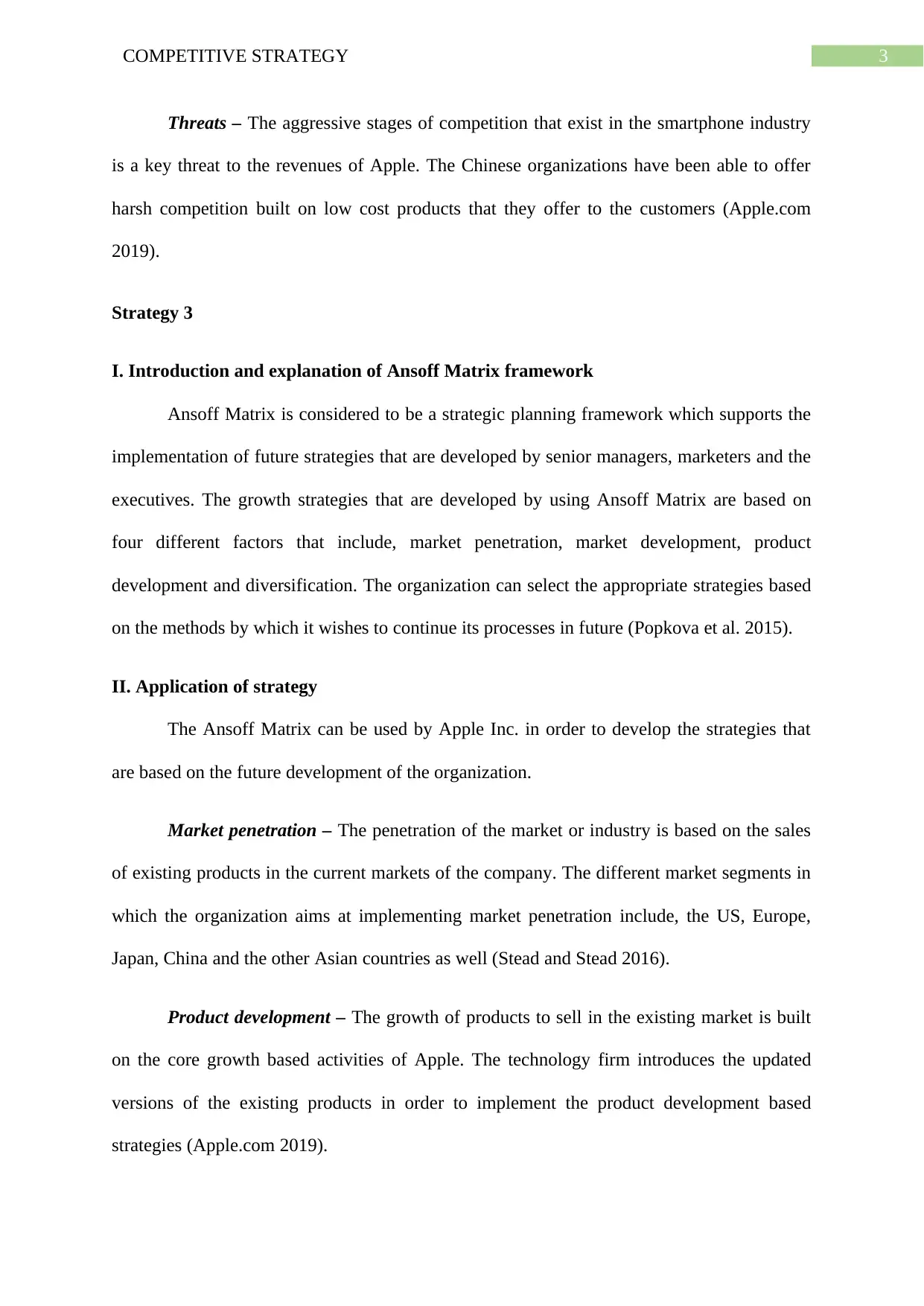
3COMPETITIVE STRATEGY
Threats – The aggressive stages of competition that exist in the smartphone industry
is a key threat to the revenues of Apple. The Chinese organizations have been able to offer
harsh competition built on low cost products that they offer to the customers (Apple.com
2019).
Strategy 3
I. Introduction and explanation of Ansoff Matrix framework
Ansoff Matrix is considered to be a strategic planning framework which supports the
implementation of future strategies that are developed by senior managers, marketers and the
executives. The growth strategies that are developed by using Ansoff Matrix are based on
four different factors that include, market penetration, market development, product
development and diversification. The organization can select the appropriate strategies based
on the methods by which it wishes to continue its processes in future (Popkova et al. 2015).
II. Application of strategy
The Ansoff Matrix can be used by Apple Inc. in order to develop the strategies that
are based on the future development of the organization.
Market penetration – The penetration of the market or industry is based on the sales
of existing products in the current markets of the company. The different market segments in
which the organization aims at implementing market penetration include, the US, Europe,
Japan, China and the other Asian countries as well (Stead and Stead 2016).
Product development – The growth of products to sell in the existing market is built
on the core growth based activities of Apple. The technology firm introduces the updated
versions of the existing products in order to implement the product development based
strategies (Apple.com 2019).
Threats – The aggressive stages of competition that exist in the smartphone industry
is a key threat to the revenues of Apple. The Chinese organizations have been able to offer
harsh competition built on low cost products that they offer to the customers (Apple.com
2019).
Strategy 3
I. Introduction and explanation of Ansoff Matrix framework
Ansoff Matrix is considered to be a strategic planning framework which supports the
implementation of future strategies that are developed by senior managers, marketers and the
executives. The growth strategies that are developed by using Ansoff Matrix are based on
four different factors that include, market penetration, market development, product
development and diversification. The organization can select the appropriate strategies based
on the methods by which it wishes to continue its processes in future (Popkova et al. 2015).
II. Application of strategy
The Ansoff Matrix can be used by Apple Inc. in order to develop the strategies that
are based on the future development of the organization.
Market penetration – The penetration of the market or industry is based on the sales
of existing products in the current markets of the company. The different market segments in
which the organization aims at implementing market penetration include, the US, Europe,
Japan, China and the other Asian countries as well (Stead and Stead 2016).
Product development – The growth of products to sell in the existing market is built
on the core growth based activities of Apple. The technology firm introduces the updated
versions of the existing products in order to implement the product development based
strategies (Apple.com 2019).
Paraphrase This Document
Need a fresh take? Get an instant paraphrase of this document with our AI Paraphraser
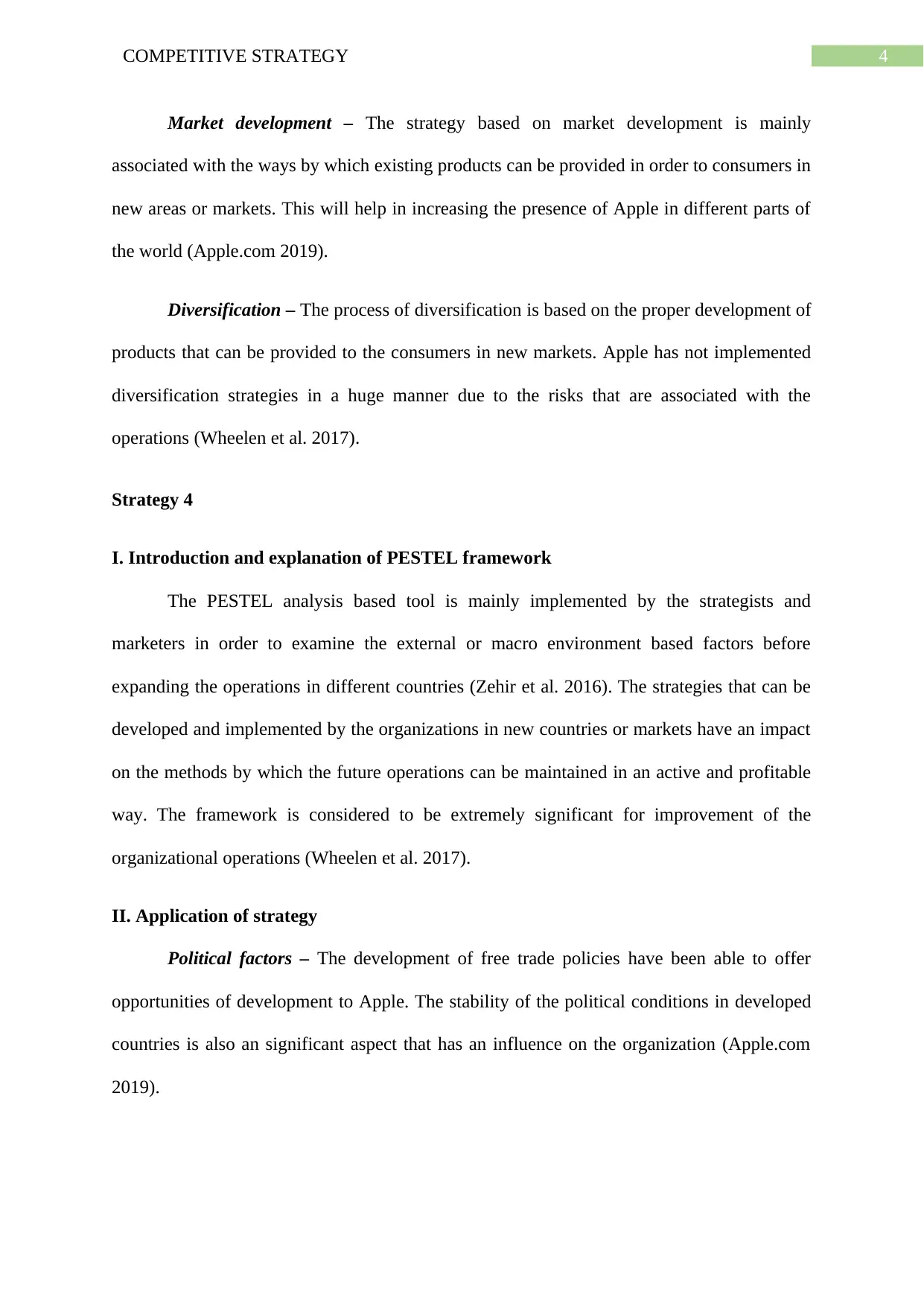
4COMPETITIVE STRATEGY
Market development – The strategy based on market development is mainly
associated with the ways by which existing products can be provided in order to consumers in
new areas or markets. This will help in increasing the presence of Apple in different parts of
the world (Apple.com 2019).
Diversification – The process of diversification is based on the proper development of
products that can be provided to the consumers in new markets. Apple has not implemented
diversification strategies in a huge manner due to the risks that are associated with the
operations (Wheelen et al. 2017).
Strategy 4
I. Introduction and explanation of PESTEL framework
The PESTEL analysis based tool is mainly implemented by the strategists and
marketers in order to examine the external or macro environment based factors before
expanding the operations in different countries (Zehir et al. 2016). The strategies that can be
developed and implemented by the organizations in new countries or markets have an impact
on the methods by which the future operations can be maintained in an active and profitable
way. The framework is considered to be extremely significant for improvement of the
organizational operations (Wheelen et al. 2017).
II. Application of strategy
Political factors – The development of free trade policies have been able to offer
opportunities of development to Apple. The stability of the political conditions in developed
countries is also an significant aspect that has an influence on the organization (Apple.com
2019).
Market development – The strategy based on market development is mainly
associated with the ways by which existing products can be provided in order to consumers in
new areas or markets. This will help in increasing the presence of Apple in different parts of
the world (Apple.com 2019).
Diversification – The process of diversification is based on the proper development of
products that can be provided to the consumers in new markets. Apple has not implemented
diversification strategies in a huge manner due to the risks that are associated with the
operations (Wheelen et al. 2017).
Strategy 4
I. Introduction and explanation of PESTEL framework
The PESTEL analysis based tool is mainly implemented by the strategists and
marketers in order to examine the external or macro environment based factors before
expanding the operations in different countries (Zehir et al. 2016). The strategies that can be
developed and implemented by the organizations in new countries or markets have an impact
on the methods by which the future operations can be maintained in an active and profitable
way. The framework is considered to be extremely significant for improvement of the
organizational operations (Wheelen et al. 2017).
II. Application of strategy
Political factors – The development of free trade policies have been able to offer
opportunities of development to Apple. The stability of the political conditions in developed
countries is also an significant aspect that has an influence on the organization (Apple.com
2019).
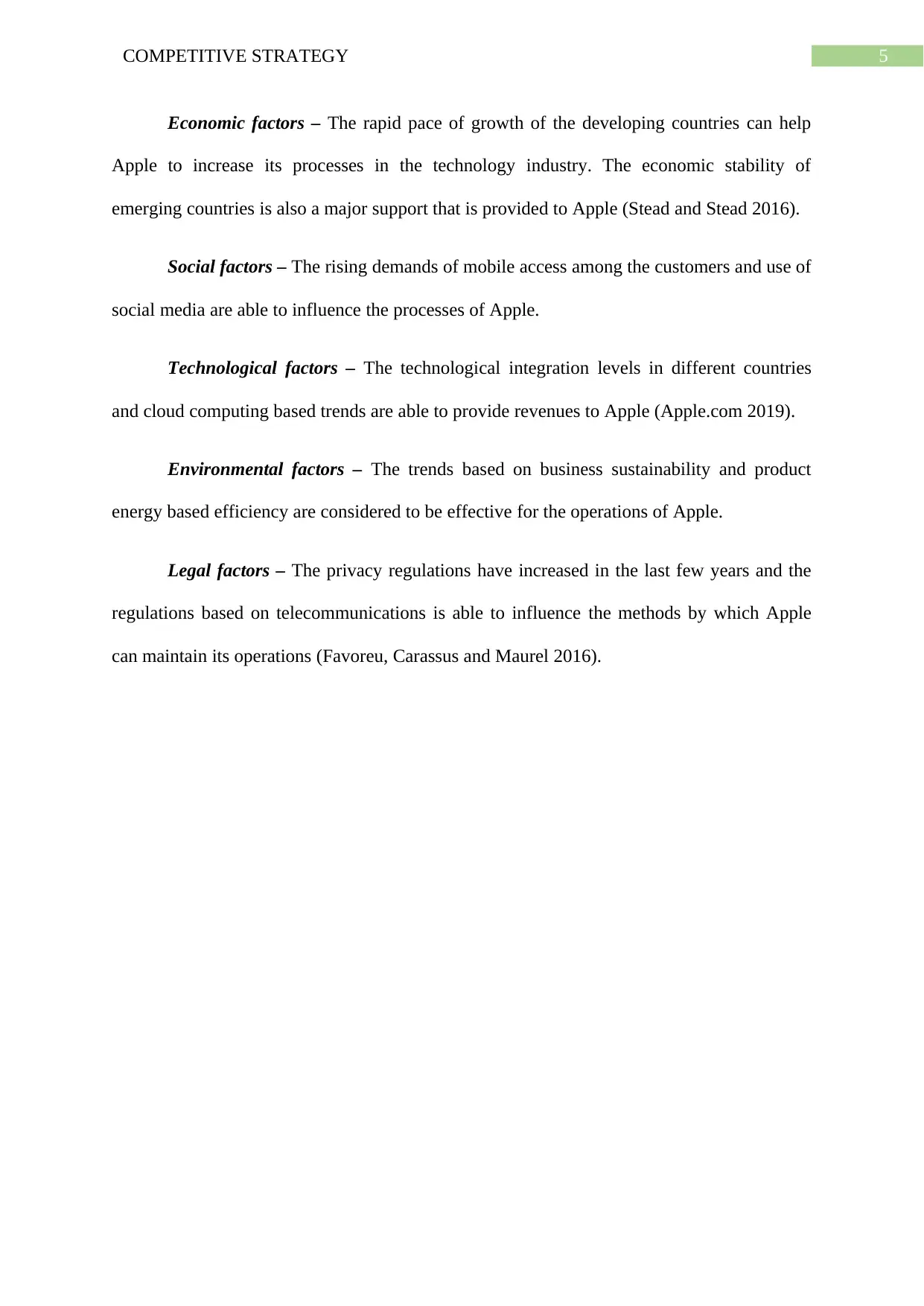
5COMPETITIVE STRATEGY
Economic factors – The rapid pace of growth of the developing countries can help
Apple to increase its processes in the technology industry. The economic stability of
emerging countries is also a major support that is provided to Apple (Stead and Stead 2016).
Social factors – The rising demands of mobile access among the customers and use of
social media are able to influence the processes of Apple.
Technological factors – The technological integration levels in different countries
and cloud computing based trends are able to provide revenues to Apple (Apple.com 2019).
Environmental factors – The trends based on business sustainability and product
energy based efficiency are considered to be effective for the operations of Apple.
Legal factors – The privacy regulations have increased in the last few years and the
regulations based on telecommunications is able to influence the methods by which Apple
can maintain its operations (Favoreu, Carassus and Maurel 2016).
Economic factors – The rapid pace of growth of the developing countries can help
Apple to increase its processes in the technology industry. The economic stability of
emerging countries is also a major support that is provided to Apple (Stead and Stead 2016).
Social factors – The rising demands of mobile access among the customers and use of
social media are able to influence the processes of Apple.
Technological factors – The technological integration levels in different countries
and cloud computing based trends are able to provide revenues to Apple (Apple.com 2019).
Environmental factors – The trends based on business sustainability and product
energy based efficiency are considered to be effective for the operations of Apple.
Legal factors – The privacy regulations have increased in the last few years and the
regulations based on telecommunications is able to influence the methods by which Apple
can maintain its operations (Favoreu, Carassus and Maurel 2016).
⊘ This is a preview!⊘
Do you want full access?
Subscribe today to unlock all pages.

Trusted by 1+ million students worldwide
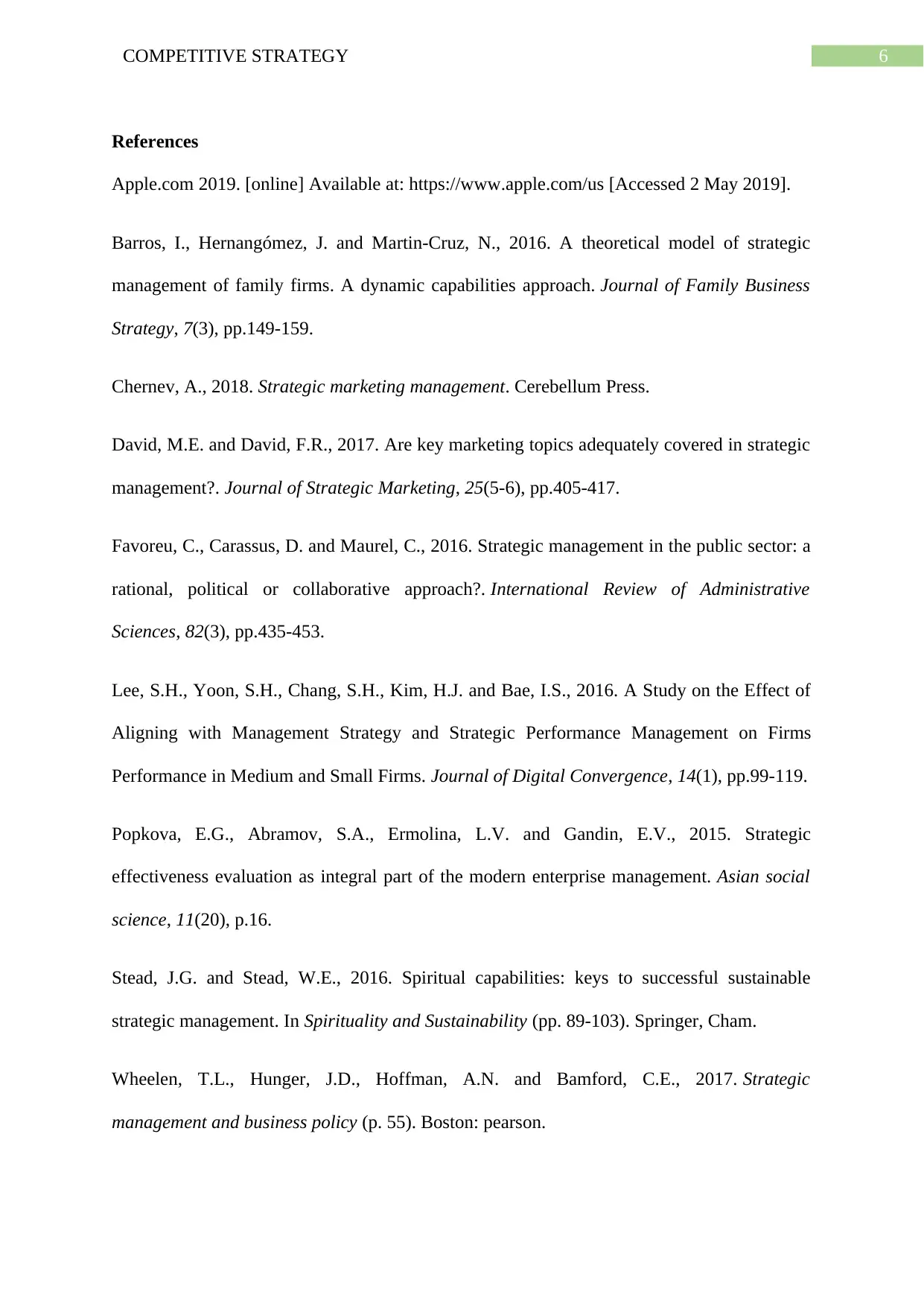
6COMPETITIVE STRATEGY
References
Apple.com 2019. [online] Available at: https://www.apple.com/us [Accessed 2 May 2019].
Barros, I., Hernangómez, J. and Martin-Cruz, N., 2016. A theoretical model of strategic
management of family firms. A dynamic capabilities approach. Journal of Family Business
Strategy, 7(3), pp.149-159.
Chernev, A., 2018. Strategic marketing management. Cerebellum Press.
David, M.E. and David, F.R., 2017. Are key marketing topics adequately covered in strategic
management?. Journal of Strategic Marketing, 25(5-6), pp.405-417.
Favoreu, C., Carassus, D. and Maurel, C., 2016. Strategic management in the public sector: a
rational, political or collaborative approach?. International Review of Administrative
Sciences, 82(3), pp.435-453.
Lee, S.H., Yoon, S.H., Chang, S.H., Kim, H.J. and Bae, I.S., 2016. A Study on the Effect of
Aligning with Management Strategy and Strategic Performance Management on Firms
Performance in Medium and Small Firms. Journal of Digital Convergence, 14(1), pp.99-119.
Popkova, E.G., Abramov, S.A., Ermolina, L.V. and Gandin, E.V., 2015. Strategic
effectiveness evaluation as integral part of the modern enterprise management. Asian social
science, 11(20), p.16.
Stead, J.G. and Stead, W.E., 2016. Spiritual capabilities: keys to successful sustainable
strategic management. In Spirituality and Sustainability (pp. 89-103). Springer, Cham.
Wheelen, T.L., Hunger, J.D., Hoffman, A.N. and Bamford, C.E., 2017. Strategic
management and business policy (p. 55). Boston: pearson.
References
Apple.com 2019. [online] Available at: https://www.apple.com/us [Accessed 2 May 2019].
Barros, I., Hernangómez, J. and Martin-Cruz, N., 2016. A theoretical model of strategic
management of family firms. A dynamic capabilities approach. Journal of Family Business
Strategy, 7(3), pp.149-159.
Chernev, A., 2018. Strategic marketing management. Cerebellum Press.
David, M.E. and David, F.R., 2017. Are key marketing topics adequately covered in strategic
management?. Journal of Strategic Marketing, 25(5-6), pp.405-417.
Favoreu, C., Carassus, D. and Maurel, C., 2016. Strategic management in the public sector: a
rational, political or collaborative approach?. International Review of Administrative
Sciences, 82(3), pp.435-453.
Lee, S.H., Yoon, S.H., Chang, S.H., Kim, H.J. and Bae, I.S., 2016. A Study on the Effect of
Aligning with Management Strategy and Strategic Performance Management on Firms
Performance in Medium and Small Firms. Journal of Digital Convergence, 14(1), pp.99-119.
Popkova, E.G., Abramov, S.A., Ermolina, L.V. and Gandin, E.V., 2015. Strategic
effectiveness evaluation as integral part of the modern enterprise management. Asian social
science, 11(20), p.16.
Stead, J.G. and Stead, W.E., 2016. Spiritual capabilities: keys to successful sustainable
strategic management. In Spirituality and Sustainability (pp. 89-103). Springer, Cham.
Wheelen, T.L., Hunger, J.D., Hoffman, A.N. and Bamford, C.E., 2017. Strategic
management and business policy (p. 55). Boston: pearson.
Paraphrase This Document
Need a fresh take? Get an instant paraphrase of this document with our AI Paraphraser
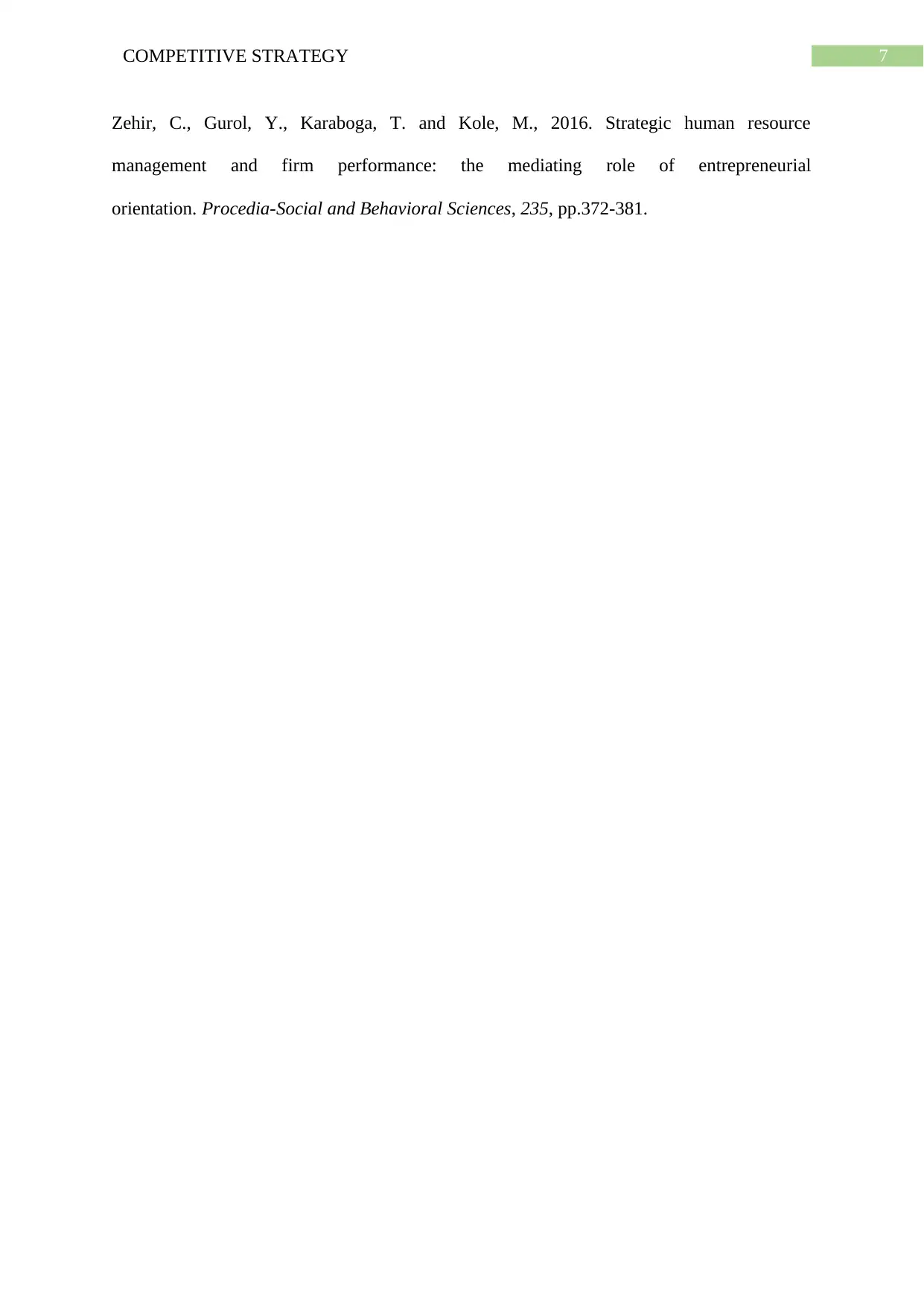
7COMPETITIVE STRATEGY
Zehir, C., Gurol, Y., Karaboga, T. and Kole, M., 2016. Strategic human resource
management and firm performance: the mediating role of entrepreneurial
orientation. Procedia-Social and Behavioral Sciences, 235, pp.372-381.
Zehir, C., Gurol, Y., Karaboga, T. and Kole, M., 2016. Strategic human resource
management and firm performance: the mediating role of entrepreneurial
orientation. Procedia-Social and Behavioral Sciences, 235, pp.372-381.
1 out of 8
Related Documents
Your All-in-One AI-Powered Toolkit for Academic Success.
+13062052269
info@desklib.com
Available 24*7 on WhatsApp / Email
![[object Object]](/_next/static/media/star-bottom.7253800d.svg)
Unlock your academic potential
Copyright © 2020–2025 A2Z Services. All Rights Reserved. Developed and managed by ZUCOL.




